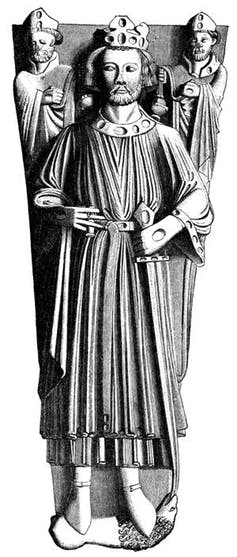What three medieval monarchs could teach Theresa May about transparency

Theresa May’s decision to join missile attacks in Syria without first consulting the House of Commons has revived a long-running debate: when deploying the monumental powers of government, is the prime minister obliged to consult parliament – and if not, should she be?
British and European heads of government have been grappling with this problem for centuries. And if Theresa May wants some pointers on how to solve it, she could do worse than look to the Middle Ages.
When the English parliamentary system emerged, it was built on a cherished principle: rulers had to take advice from a representative body of subjects before making a major decision, and whether they followed that advice or not, they had to explain their rationale. This process recognised that their subjects had a stake in the outcome, and it helped prevent rash or damaging choices. The core principle was transparency.
Read more: Fact Check: does the UK government need parliament's approval for military intervention in Syria?
Only a decision made by the visible garnering of counsel was considered lawful. Indeed, in the late 12th century, leading scholar and Archbishop of Canterbury Stephen Langton argued that when a decision was made by counsel subjects were obliged to obey orders for its execution, even when they felt it was wrong – and conversely, if the process was lacking, they were obliged to disobey.
This value was tested time and again, helping set the standard for what made a lawful decision. Here are three examples of medieval politics at work.
Out in the open
For much of the Middle Ages, the political elite learned their values from examples set out in history and literature. The greatest model of good rulership was Charlemagne, who was crowned Holy Roman Emperor in 800AD and whose life became a legend sung in feasting halls in the centuries that followed.
When deciding whether to go to war or sue for peace, Charlemagne would assemble his men, stroking his beard as he weighed their conflicting advice. He held his councils in an orchard, choosing an outdoor venue precisely so that all could see, literally, how the decision was made.
Medieval rulers who disregarded this commitment to transparency did so at their peril.

England’s King John (1199-1216) made decisions with a gang of cronies who had no authority to represent the polity he ruled. He did so in back rooms and in his chamber – literally behind closed doors, where no one could see how the decisions were made.
John’s behaviour is particularly reminiscent of Theresa May’s reliance on unelected special advisors. The use of a tiny and controlling coterie caused May serious political grief after the Conservatives’ disastrous 2017 election campaign – but in 1215, John’s similar style helped to provoke a full-scale rebellion. When Magna Carta was sealed in 1215, the king was forced to guarantee the role of counsel at least in levying taxes (in chapter 12) and to describe the representative body authorised to give that counsel (in chapter 14).
A radical response
Magna Carta meant that John’s heir, Henry III (1216-72), was compelled to consult the body known from 1236 as “parliament” before levying taxes. Yet still he committed his country to an expensive war (in the Mediterranean) on the advice only of his intimates, and his general failure to rule transparently provoked a radical response.
In 1258, a cohort of barons seized the reins of power, establishing a council to rule in Henry’s place and decreeing that parliament would henceforth meet three times a year (not only in response to royal summons) – a decree that established for the first time the role of wider consultation in deciding policy.
These principles were pushed further in 1264 when the baronial leader, Simon de Montfort, defeated the king in battle, held him prisoner and sought to establish rule by council permanently. A constitution was drawn up: it described the electoral process for a ruling council of nine, defined the council’s powers, and decreed that it could only pass a decision with a two-thirds majority.
The constitution was published across the kingdom – and crucially, at a parliament. Held at Westminster between January and March 1265 this meeting was the first time that representatives of the towns were summoned to discuss the running of the kingdom. For this reason, it has often been called “the first House of Commons”.
Simon de Montfort’s radical regime was cut short when he and his men were slain in battle at Evesham six months after the parliament’s close. Nonetheless, his government had set a rigorous standard for government transparency.
Then as now, the fundamental point wasn’t whether the decision was “good” or “bad” according to its rationale or outcome, nor the size of the representative body consulted; indeed, under Simon de Montfort’s regime, sensitive military issues were decided by the council and not taken before parliament. The point was that the process of decision-making had to be both visible and understood.
As rulers throughout the centuries have discovered one way or another, this is the critical criterion for lawful rule in any system of consensual government. Theresa May, take note.
This article was originally published on The Conversation. Read the original article.

Sophie Therese Ambler does not work for, consult, own shares in or receive funding from any company or organisation that would benefit from this article, and has disclosed no relevant affiliations beyond their academic appointment.

 Yahoo News
Yahoo News 